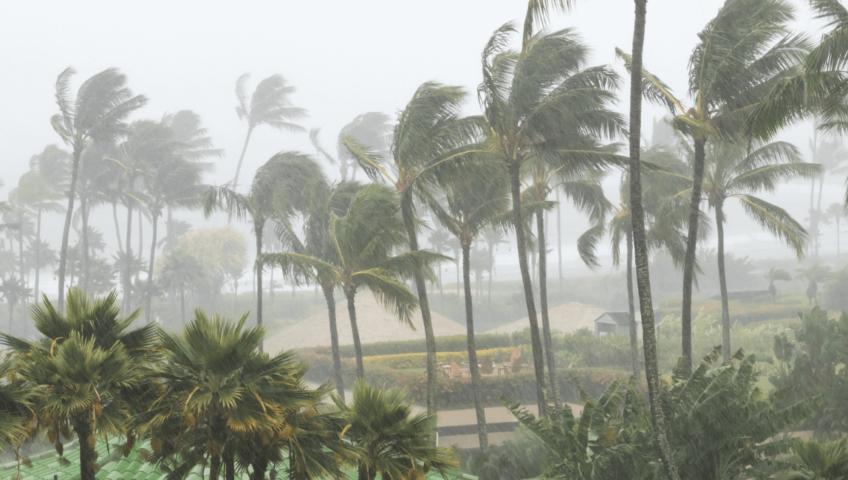Even in warm and sunny Barbados, wind, rain and storms can significantly damage your home. During a storm or hurricane, gusts of wind and drenching rain can cause your home to fail in a variety of ways – and this can be a particular worry if you are overseas at the time.
In tropical climates like ours, it is critical to ensure that your home is well-prepared to resist the ravages of tropical storms and hurricanes. As a result, it is crucial to consider while designing your home. You need to build resilience into the structure.
As the world struggles to adapt to climate change, extreme tropical weather systems may become more often and severe. As a result, having a basic understanding of how wind forces, particularly in a storm or hurricane, can affect your property is beneficial.
The Effects of Wind Forces
Several factors determine the effect of wind forces on a structure. The wind speed and the geographical circumstances surrounding your home are examples of these. The extent of the impact will also be determined by building variables such as shape, direction, height, and structural properties.
The Effects of Different Wind Speeds
Tropical locations are vulnerable to a range of high-wind weather phenomena.
Tropical depressions, storms, and hurricanes are common in the Caribbean. They can produce high wind speeds, which can have various effects on your home.
The Saffir-Simpson Wind Scale method assigns five levels of intensity to hurricanes.
Topical depressions
Tropical depressions have wind speeds ranging from 30 to 38 mph (miles per hour) or 48 to 62 km/h (kilometres per hour).
Wind damage to well-constructed homes is negligible to non-existent. Poorly constructed or impermanent structures, on the other hand, may withstand modest damage.
Tropical Storm
Wind speeds in tropical storms range from 39 to 73 mph (63 to 118 km/h).
Storm gusts of less than 51 mph can cause modest damage to temporary and shoddily-built structures.
Wind speeds of 50 to 60 mph will moderately damage houses with poor to mediocre construction. Damage to shingles, fascias, siding, and fences is possible. In severe gusts, some windows may potentially be blown out.
Hurricane Category One
A Category 1 hurricane has winds of 74 to 95 mph (119 to 153 km/h).
Some well-built frame houses may suffer roof and siding damage due to strong winds. These winds may also cause harm to your home by causing trees and huge branches to fall.
Because severe wind forces will inflict extensive damage to utility poles and power lines, you will most likely be without energy.
Hurricane Category 2
Hurricanes in category two have wind speeds ranging from 96 to 110 mph (154 to 177 km/h).
These winds are hazardous at this point. They may do considerable harm to well-built framed houses and roofs.
Hurricane Category 3
Wind speeds in Category 3 range from 111 to 129 mph (178 to 208 km/h), and the category is upgraded to “major” and capable of wreaking havoc. Even roofs and structures with properly designed framed roofs and walls may sustain substantial damage. Tree branches will snap or uproot entirely from the ground.
Electricity wires and poles will be severely damaged. As a result, you may be without power for several weeks.
Hurricane Category 4
Hurricanes and typhoons in category four have winds of 130 to 156 mph (209 to 251 km/h).
These winds have the potential to cause significant damage. The majority of lightweight roofs will be demolished. Furthermore, many homes with a framed structure will suffer substantial damage.
Wind damage to properly constructed reinforced concrete roofs and block walls are expected to be minor. Unprotected or non-impact-resistant windows and doors, on the other hand, are liable to fail in strong winds.
Hurricane Category 5
A category five storm hurricane is dangerous with winds of up to 252 km/h (157 mph).
These winds will destroy most framed homes. All framed roofs will fail.
A Category 5 hurricane should, in general, not impact well-built concrete masonry and reinforced concrete structures.
Here are a few things to think about now that we’ve covered some of the ways significant wind forces can affect your home.
Construction and Materials
Your home’s performance in a severe wind weather event is determined by the materials and construction type used. In the event of a major hurricane, this element is critical.
Lightweight framed construction for your walls and roofs is an excellent thermal response in a hot tropical region. They can also be designed and built to survive a hurricane or a storm. However, with significant weather systems such as category 4 and 5 hurricanes, they are more prone to fail.
A well-constructed concrete masonry or reinforced concrete home is more naturally resistant to the forces of the wind.
Steel-reinforced concrete walls and roofs will likely be the safest material in a strong category four or five storms. They may not be perfect for thermal comfort in hot tropical regions, but they will withstand the pressure of strong winds. They are also resistant to wind-borne debris.
Your Home’s Dimensions and Shape
The shape of your home influences how wind forces interact with it.
It is easier for the wind to flow a circular or multi-sided house (such as an octagon) than a square or rectangular one.
Wind forces can cause an increase in pressure in homes with long flat sides.
Roof Types and Shapes
The shape of your roof will also influence its durability. For example, a circular roof or several sloping panels, such as a hexagon or octagon, will function better.
A dome roof has a similar effect, allowing wind to flow more easily around it. The wind has less resistance because it flows readily around and over the top.
Even four sloping panels on a hip roof outperform two slanted panels on a gable roof.
Wind uplift is less of an issue on steeper pitches like 30 to 45 degrees than on level fields.
As previously stated, reinforced concrete roof slabs will naturally withstand more powerful storms such as category four and five hurricanes.
Windows and doors
During a hurricane, windows and doors are particularly vulnerable.
These can be blown right out of their opening by strong winds. Furthermore, wind-borne debris can easily pierce a non-impact-resistant window. So, protecting windows and doors is a good idea.
You can use properly constructed storm shutters to protect your window and door openings. Temporary plywood shutters with a thickness of at least 5/8 inch can also be installed.
On the other hand, impact-resistant glass will keep things carried up by the wind from entering your home. When something hits this one-of-a-kind glass, it may shatter, but it will not let anything pass through.
Branches and trees
If large tree branches or entire trees fall on your house, they can cause significant damage.
As a result, trimming tree branches that hang over your house is a good idea.
Though trees are fantastic for giving shade to and around the home in the summer, they can be dangerous in a storm or hurricane. As a result, think about growing large trees away from your house.
If you would like to discuss building wind resistance and resilience into your property, then contact the team at Berkan Construction. We will be happy to share our knowledge and experience of building in Barbados with you.




